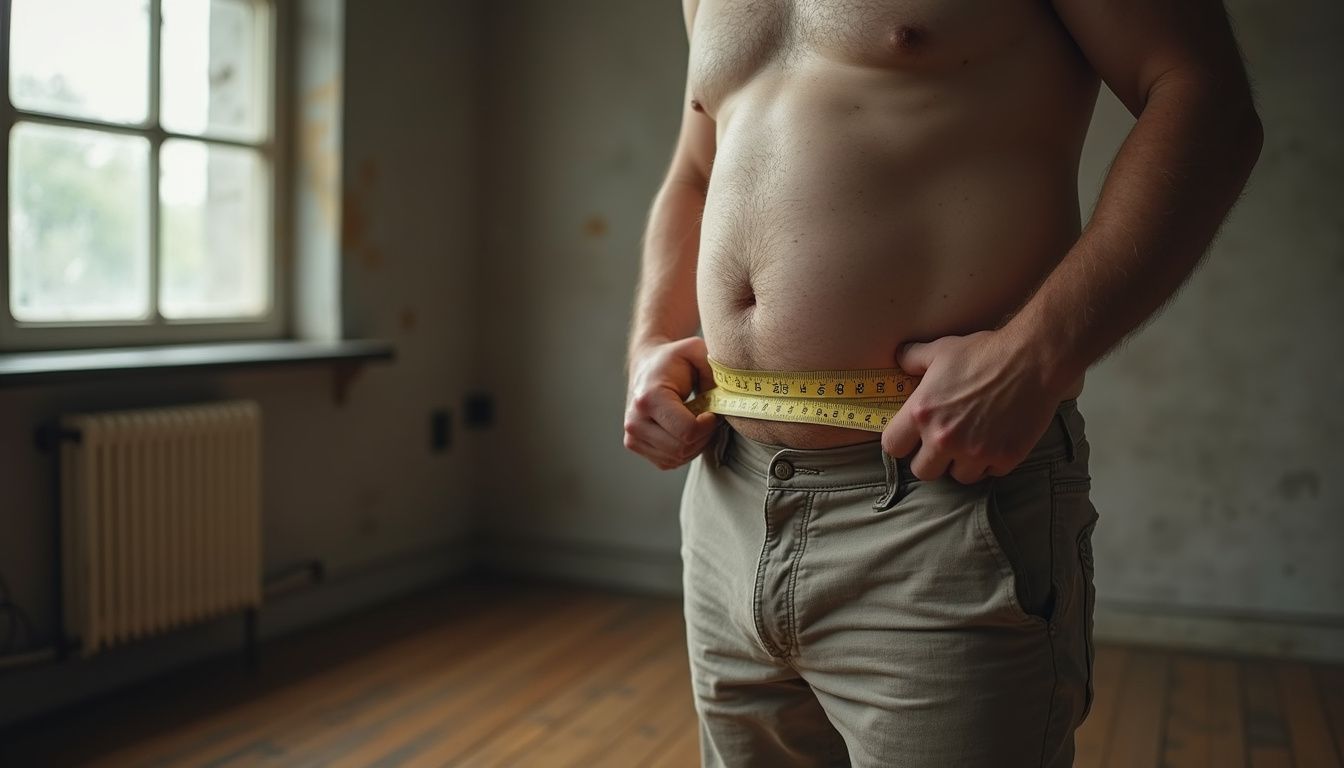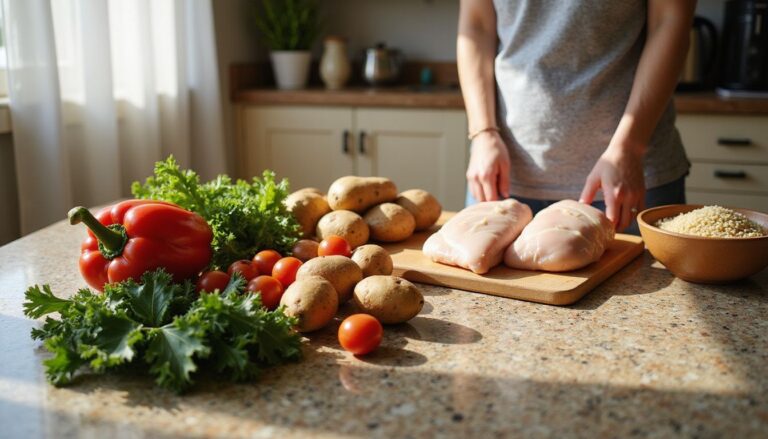Top Foods To Lose Belly Fat Fast: A Guide To Shedding Weight And Belly Fat
Our Nutrition Assistant AI Suite will transform your body. You will lose fat, get toned, and build muscle. Gain confidence and optimal health.
Struggling with a stubborn waistline can feel frustrating. The good news is that small, steady changes add up. Research suggests eating more soluble fiber each day can reduce belly fat by about 4 percent over five years. If you want to lose belly fat, focusing on the right foods, habits, and routines makes the process easier to manage.
This guide explains which foods help, how they work inside your body, and simple steps you can start today. You will also learn why sleep, stress control, and regular movement matter as much as calories.
Key Takeaways
- Increasing daily soluble fiber may reduce belly fat by roughly 4 percent over five years, based on prospective studies.
- High-protein choices like lean meats, eggs, legumes, and fatty fish support fat loss by improving fullness and preserving muscle mass during a calorie deficit.
- Visceral fat, the fat around your organs, raises risk for heart disease, type 2 diabetes, stroke, metabolic syndrome, and certain cancers, according to Harvard Medical School.
- Swapping refined carbs and sugary drinks for whole grains, fruits, vegetables, water, or green tea can lower abdominal fat while improving metabolic health.
- Pair healthy eating with at least 150 minutes of aerobic exercise per week plus strength training for the best long-term waistline results.

Understanding Different Types of Belly Fat and Their Risks

There are two main types of belly fat. Subcutaneous fat sits under the skin. Visceral fat collects deeper in the abdomen and surrounds your organs. Too much of either kind raises health risks, but visceral fat is more harmful.
What is the difference between subcutaneous and visceral fat?
Subcutaneous fat is the soft layer you can pinch on your arms, thighs, or belly. Visceral fat hides behind the abdominal wall and fills spaces around the liver, stomach, and intestines. Doctors also call it intra-abdominal fat.
You cannot grab visceral fat with your fingers because muscles and connective tissue cover it. This hidden fat is linked to inflammation and hardening of the arteries.
Harvard Medical School reports that excess visceral fat increases risk for heart disease, type 2 diabetes, stroke, metabolic syndrome, and some cancers. Physical activity often reduces visceral fat first, but sit-ups alone will not remove fat from one spot.
“Carrying excess intra-abdominal adipose tissue can lead to greater cardiovascular risk factors.”
There is also intramuscular fat, which is stored within skeletal muscle fibers. It behaves differently than fat around organs or under the skin.
Understanding where fat sits helps you choose the most effective steps for your health and waistline.
How does belly fat impact your health?
Subcutaneous fat lies under the skin, but visceral fat wraps organs like the liver and intestines. High visceral fat is tied to higher risks of type 2 diabetes, heart disease, high blood pressure, and some cancers.
Waist size is a useful signal. Above 35 inches for most women or 40 inches for most men, risk rises. Visceral fat fuels inflammation and insulin resistance, which makes weight control harder and harms blood vessels.
Short sleep, less than five hours per night, is linked with significant weight gain in studies. Stress hormones like cortisol also push fat storage toward the abdomen. Improving sleep, lowering stress, and moving more can all help reverse this trend.
Regular aerobic exercise, about 150 minutes weekly, plus strength training two or more times per week helps shrink waist size, improve mood, and build fitness. These habits support long-term health, not just the number on the scale.
How Does Diet Affect Belly Fat Loss?
Food choices drive energy balance. To lose fat, you need a calorie deficit, which means eating slightly fewer calories than you burn. Tracking intake for a week can show patterns and help you make better swaps.
Higher protein intake supports belly fat loss. Protein increases fullness, protects muscle, and may curb cravings. Good options include lean meat, eggs, beans, and lentils.
Added sugars, especially fructose in sugary foods and drinks, are linked to more visceral fat and higher risk of type 2 diabetes and heart disease. Highly processed foods also bring extra sodium, sugar, and unhealthy fats that push calories up.
Mediterranean-style eating, rich in olive oil, nuts, fish, yogurt, fruits, vegetables, and whole grains, has strong evidence for better weight and cardiometabolic health. It naturally limits refined carbs and ultra-processed snacks.
A short example can help: using a simple app for two weeks can reveal where liquid calories and convenience foods slip in. Replacing soda with water and adding a cup of non-starchy vegetables at lunch often leads to steady, realistic losses.
Best High-Protein Foods to Help Lose Belly Fat
Protein helps you feel satisfied and protects muscle while you lose weight. More muscle means a slightly higher metabolism, so your body burns more calories, even at rest.
Why choose lean meats and poultry for fat loss?
Skinless chicken, turkey, and other lean cuts offer high protein with less saturated fat. Protein triggers peptide YY, a hormone that increases fullness, which helps keep daily calories in check.
Including lean meats can help preserve muscle during weight loss. With more lean tissue, your body burns a few more calories around the clock. Choose these foods instead of processed or fatty meats if you are aiming to reduce your waistline and protect heart health.
How do fatty fish like salmon and tuna help reduce belly fat?
Fatty fish such as salmon, sardines, mackerel, herring, and tuna provide top-quality protein plus omega-3 fatty acids. Omega-3s are healthy fats that may reduce visceral fat and improve markers of metabolic health.
Eating fatty fish two to three times per week fits many plans. If you do not eat fish, algae-based omega-3 supplements can be a plant alternative. Many people notice better fullness and smaller waist measurements after adding these meals on a regular schedule.
What role do eggs play in belly fat loss?
Eggs are rich in complete protein, which means they supply all the essential amino acids your body needs. This helps you keep muscle while losing fat.
Starting the day with eggs can improve appetite control for hours. People following higher protein diets that include eggs often report fewer cravings and better total calorie control. Eggs are also easy to prepare and fit into many meals without added sugars.
How can legumes like beans and lentils support weight loss?
Beans and lentils provide a strong mix of protein and fiber. Fiber slows digestion and steadies blood sugar, which helps you feel full longer. This makes it easier to maintain a calorie deficit without losing muscle.
Regular intake is linked with healthier body composition, including less visceral fat. Aim for several servings each week. Add legumes to soups, salads, tacos, or grain bowls for simple, budget-friendly meals.
High-Fiber Foods That Promote Weight Loss
Fiber supports a healthy gut and helps control hunger. Soluble fiber forms a gel in the digestive tract, which slows digestion and can reduce fat storage.
Which fruits are best for losing belly fat?
Berries, apples, and pears are standout options. They are high in soluble fiber and lower in calories than many snacks. Whole fruits are better than juice because they are more filling and do not spike blood sugar as quickly.
People who eat more whole fruit tend to have less abdominal fat than those who drink fruit juices. Swapping a morning glass of juice for an apple is a simple example that can cut calories and reduce cravings later in the day.
What vegetables help with belly fat reduction?
Leafy greens like spinach, kale, and chard are low in calories and high in fiber. Cruciferous vegetables such as broccoli, cauliflower, and Brussels sprouts also bring fiber and helpful plant compounds.
Fill half your plate with non-starchy vegetables at lunch and dinner. This strategy supports fullness, steady blood sugar, and lower total calories. Many people find that an extra cup of broccoli at midday keeps late afternoon snacking in check.
Why include whole grains like oats and quinoa in your diet?
Whole grains contain the bran and germ, which means more fiber and nutrients. Oats and quinoa help you stay full longer, which makes calorie control easier.
Data from the Framingham Heart Study found that people who ate more whole grains were less likely to carry excess abdominal fat than those who favored refined grains. A warm bowl of oatmeal can keep hunger steady until midday and reduce the urge for sweet snacks.
Healthy Fats That Help Reduce Belly Fat
Healthy fats improve satiety, support heart health, and may reduce fat stored in the abdomen. The key is quality and proper portions.
How does avocado aid in fat loss?
Avocados are rich in monounsaturated fat, often called MUFA. Diets higher in these fats are linked with smaller waists and better insulin sensitivity, especially in postmenopausal women.
Avocado also supplies fiber. Spreading avocado on toast instead of butter or mayonnaise can reduce empty calories while keeping meals satisfying. The combination of fiber and healthy fat supports stable energy and fewer between-meal snacks.
Why eat nuts and seeds to reduce belly fat?
Nuts and seeds deliver healthy fats, protein, and fiber in a compact serving. Almonds, walnuts, chia, flax, and pumpkin seeds can help control appetite and support a lower-calorie pattern without hunger.
Because nuts are energy dense, keep portions moderate. A small handful can hold you over between meals. These foods fit well in Mediterranean-style eating, which is associated with less abdominal fat over time.
What benefits does olive oil provide for belly fat reduction?
Olive oil is a primary source of monounsaturated fat in Mediterranean diets. Replacing saturated or trans fats with olive oil can improve insulin sensitivity and support a leaner waist.
It also has anti-inflammatory compounds that support metabolic and heart health. Try extra virgin olive oil on salads and cooked vegetables. Many people notice steadier appetite through the day with this simple swap.
What Foods Boost Metabolism for Faster Fat Loss?
Some foods nudge your body to burn a few more calories. Think of them as small helpers, not magic fixes.
How does green tea increase metabolism?
Green tea contains caffeine and EGCG, a plant antioxidant called a catechin. Caffeine gives a gentle lift in energy. EGCG helps your body oxidize fat, which means it uses more stored fat for fuel.
Studies show that regular green tea intake can support weight loss and smaller waist measurements. Choose unsweetened green tea to avoid extra sugar. It hydrates as well, which supports exercise and daily energy.
Can spicy foods like hot peppers help burn belly fat?
Hot peppers contain capsaicin, the compound that brings heat. Capsaicin can briefly increase energy expenditure and may help curb appetite for some people.
Add sliced jalapeño, cayenne, or hot sauce to meals for flavor without extra calories. Spicy foods work best as part of a balanced plan that includes regular movement and mindful portions.
Which Probiotic-Rich Foods Improve Gut Health?
Your gut houses trillions of microbes. A healthy mix can support better digestion, calmer appetite signals, and improved body composition.
How do yogurt and kefir support weight loss?
Yogurt and kefir supply protein and probiotics, which are live beneficial bacteria. Certain strains may reduce visceral fat and improve blood sugar control. Higher protein also boosts fullness and helps you keep muscle while you lose weight.
Choose plain versions to avoid added sugars. A serving of Greek yogurt as a snack or breakfast can keep hunger steady for hours and improve digestive comfort.
What benefits do kimchi and sauerkraut offer?
Kimchi and sauerkraut are fermented vegetables that deliver probiotics without dairy. They also add fiber and micronutrients with very few calories.
Regular intake supports a diverse gut microbiota, which is linked with healthier weight and less abdominal fat. Add a few forkfuls to grain bowls, tacos, or salads for crunch and tang.
How Does Hydration Influence Fat Loss?
Water supports metabolism, helps control appetite, and makes exercise feel easier. Hydration is a simple habit with a big payoff.
Why is drinking water important for losing belly fat?
Drinking water before meals can help you eat fewer calories. Replacing sugary beverages with water lowers sugar intake and reduces fat storage in the abdomen.
Water aids digestion and helps your body transport fat to be used for energy during activity. Cold water can feel refreshing before workouts and may help you perform better and recover faster.
What are the best herbal teas and calorie-free drinks for fat loss?
Plain water, sparkling water with citrus, unsweetened iced tea, and herbal teas are all smart choices. They hydrate without adding sugar or calories.
Peppermint, ginger, and chamomile teas can be soothing after meals. Many people find that switching from soda to sparkling water reduces bloating and afternoon energy crashes.
Which Foods Should You Avoid to Lose Belly Fat Effectively?
Some items make it much harder to slim your waist. Limit these and you will notice progress faster.
Why avoid sugary beverages?
Sodas, sweet tea, fruit punch, and sweet cocktail mixers add fast sugar with little fullness. An 8 ounce glass of apple juice contains about 24 grams of sugar and almost no fiber.
Liquid calories do not register the same way as solid food, so it is easy to overdrink. High intake of sugary drinks is linked to more belly fat, higher diabetes risk, and fatty liver. Whole fruit is better because it brings fiber that slows absorption.
How do refined carbs affect belly fat?
Refined grains like white bread, white rice, pastries, and many cereals spike blood sugar. That spike can drive hunger and extra fat storage, especially around the waist.
People who choose more whole grains have a lower chance of carrying excess abdominal fat than those who favor refined grains. Swapping to oats, brown rice, quinoa, or whole grain breads is a straightforward improvement.
What are trans fats and why should they be avoided?
Trans fats are often listed as partially hydrogenated oils on labels. They appear in some baked goods, snack foods, and spreads. Trans fats increase inflammation and raise heart disease risk.
They also promote visceral fat gain, which harms long-term health. Check ingredient lists and skip products with partially hydrogenated oils. Choosing whole and minimally processed foods reduces your exposure.
How to Combine Diet with Lifestyle Changes for Best Results
Food is one lever. Daily routines like mindful eating, exercise, sleep, and stress control pull the others. Together they shape your waistline.
What is portion control and how does mindful eating help?
Portion control means serving reasonable amounts at each meal. It supports a consistent calorie deficit without feeling deprived. Using a food diary or app for a week builds awareness fast.
Mindful eating is paying attention to hunger, fullness, and taste. Eat slower, pause between bites, and avoid screens at meals. These habits improve satisfaction and reduce overeating.
How does regular exercise, including aerobic and strength training, aid fat loss?
Aerobic exercise like brisk walking, cycling, or swimming burns calories and improves heart health. Aim for 150 minutes a week or more for steady progress. Longer weekly totals can speed change for some people.
Strength training builds or preserves muscle. Muscle tissue burns more energy than fat at rest. Two or more sessions weekly help protect muscle while you lose fat. This combo reduces both visceral and subcutaneous fat over time and lowers insulin levels, which supports fat use for energy.
What stress management techniques support belly fat reduction?
Chronic stress raises cortisol, a hormone that encourages abdominal fat storage. Practices like yoga, walking outdoors, breathing drills, or short meditations can lower stress and improve sleep.
Aim for 7 to 9 hours of sleep each night. Balanced training with planned rest days prevents overtraining, which can keep cortisol high. A friend or group can also help you stay on track during busy weeks.
What Are Some Sample Meals for Losing Belly Fat?
Build meals around protein, fiber, and healthy fats. These keep you full, steady your blood sugar, and support workouts like intervals or strength sessions.
What is a good breakfast for belly fat loss?
Try scrambled eggs with spinach, plain Greek yogurt with berries, or oatmeal topped with nuts and cinnamon. Add avocado slices or a few almonds for healthy fat.
Skip sugary cereals and pastries, which can spike hunger later. A cup of green tea at breakfast may provide a small metabolism boost without extra calories.
What lunch options support fat reduction?
Grilled chicken or tofu with quinoa, mixed greens, cherry tomatoes, and avocado is a smart base. Dress with olive oil and lemon for flavor and healthy fats.
Swap refined grains for brown rice or bulgur. Add beans or lentils for extra fiber and protein. A side of kimchi or sauerkraut can support gut health. Choose water or unsweetened tea to avoid hidden liquid calories.
Which dinners help reduce belly fat?
Make dinner light but satisfying. Salmon or tuna with steamed broccoli and quinoa brings protein, fiber, and omega-3s. Lentil stew with leafy greens is a good plant-based option.
Use herbs, garlic, and hot peppers instead of creamy sauces. A cup of green tea after dinner can help you wind down without sugar.
What are healthy snack ideas for fat loss?
Choose Greek yogurt with berries, hard-boiled eggs, apple slices with almond butter, or baby carrots with hummus. Small portions of nuts or seeds also work well.
Canned tuna or smoked salmon offers protein and omega-3s on busy days. Keeping ready-to-eat options in the fridge helps you skip ultra-processed snacks when hunger hits.
Frequently Asked Questions
You might still wonder how fast results appear or whether you can target only your midsection. Here are brief answers grounded in research.
What are the best foods to eat to lose belly fat quickly?
Focus on protein, fiber, and healthy fats. Examples include chicken or turkey, salmon or tuna, eggs, beans, lentils, Greek yogurt, berries, apples, leafy greens, broccoli, oats, and quinoa. Use olive oil, nuts, and seeds in small portions for satiety.
Limit sugary drinks and refined carbs to keep insulin and hunger in check. Add probiotic foods like yogurt or kimchi to support gut health.
How long does it take to see results?
Most people who follow a balanced eating plan and reach at least 150 minutes of weekly aerobic activity see changes within 4 to 8 weeks. You may notice less bloating and a slightly smaller waist before the scale moves much.
Genetics, sleep, stress, and consistency all play a role. Track your waist size and how your clothes fit. Those measures often show progress sooner than body weight alone.
Can I target belly fat specifically?
No, spot reduction is a myth. Your body loses fat from many areas at once. Core exercises build muscle but do not remove fat from only one place.
Aim for a calorie deficit, higher protein intake, regular aerobic exercise, and strength training. Manage stress and sleep well. These steps together reduce visceral fat and improve health over time.
Conclusion
Nutrition, movement, sleep, and stress control work together to help you lose belly fat. Build meals around protein, fiber, and healthy fats, and limit sugary drinks and refined carbs. Drink water often, consider green tea, and add probiotics for gut health.
Plan for at least 150 minutes of aerobic exercise each week and include strength training to protect muscle. Progress takes time, but it is worth it. If you have a medical condition, take medicines that affect weight, or have questions about safe targets, speak with a healthcare professional before starting a new plan.
FAQs
1. What foods can I take to lose belly fat quickly and improve my waistline?
Eating more nuts, fruits, and vegetables helps reduce belly fat. Nuts are rich in healthy fats and protein, which support weight loss by keeping you full longer. Studies show that people who eat nuts often have smaller waistlines compared to those who do not.
2. How does alcohol affect the long-term goal of losing pounds around the midsection?
Research shows that drinking alcohol can slow down metabolism and increase fat storage in cells, especially near the abdomen. The long-term effects of alcohol may also weaken capillaries, making it harder for your body to burn calories efficiently.
3. Are there specific exercises or foods that target abdominal cells for faster results?
While no food targets only abdominal cells directly, combining a balanced diet with regular crunches or other core exercises helps shrink fat stores under the skin around your stomach area. Eating nutrient-dense foods like nuts supports muscle growth while reducing overall body mass.
4. Can eating certain foods help blood flow through capillaries during weight loss efforts?
Foods high in antioxidants such as berries and leafy greens promote better circulation by supporting healthy capillary function throughout your body; this aids oxygen delivery to muscles during exercise routines focused on burning belly fat fast.
Summary:
Nuts, fruits, vegetables, and antioxidant-rich foods support losing belly fat fast when paired with regular exercise like crunches. Limiting alcohol intake improves metabolism and protects cell health over time while helping maintain a slimmer waistline according to evidence-based research.







